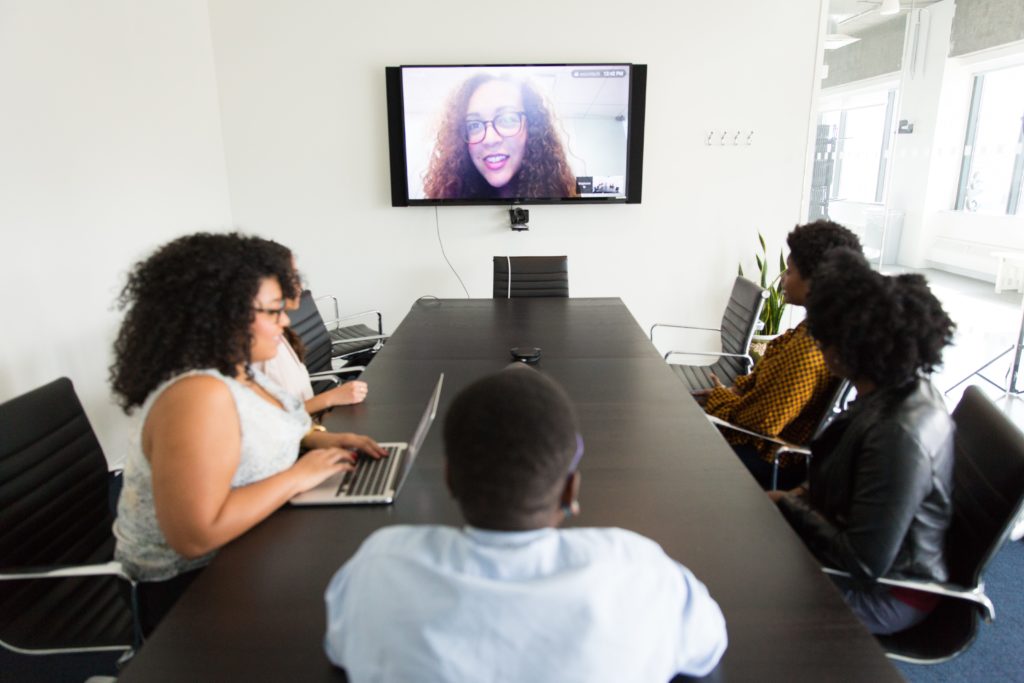Why is this important?
Professional travel is one of the greatest contributors to an organisation’s carbon footprint. Meetings, training, missions, evacuations, home leave – people travel for many reasons.
Travel is not always necessary to meet the objectives of a meeting. Organisations and individuals learned this lesson from the Covid-19 crisis and have adapted. New videoconferencing tools were adopted or generalised as alternatives to face-to-face meetings. Most organisations experienced a clear success throughout 2019 through “essential-only travel”. Moreover, since people were affected globally, the “fear of missing out” was reduced. However,it is important to keep in mind that in some cases, for organisations, the value of face-to-face interaction is fundamental. Indeed, a lot of informal and non-verbal communication is lost to videoconferencing. Shifting to online meetings presents an important opportunity for organisations to not only reduce emissions but also improve the work-life balance of their employees and reduce the associated costs spent on transport.
What is the solution?
The solution is to reduce travel – especially by air – by shifting from face-to-face meetings to remote meetings and training. Telepresence solutions include a variety of video systems, such as high-end immersive telepresence, multipurpose-room systems, desktop systems, videophones, and cloud-based software systems (such as Skype or Zoom).
Key actions
-
#1 Implement an online meetings solution
Implement an online meetings policy that aligns with the organisation’s core objectives. Ensure the solution is easy to roll out, measurable, cost-saving, and that it enhances staff well-being.
-
#2 Identify non-essential travel at all levels
Assess and define non-essential travel (e.g., HQ missions, training, professional meetings) both at the organisation-wide and individual work unit levels.
-
#3 Set a global travel reduction target
Establish an overarching target at the organisation level and incorporate it into the travel policy to drive and measure progress.
-
#4 Translate organisational targets into unit-level goals
Require heads of units to break down the global target into actionable goals for their teams, ensuring relevance and feasibility based on professional needs.
-
#5 Empower managers to lead change
Encourage unit heads to engage with their teams, assess opportunities for improvement, and lead implementation, fostering ownership and commitment.
-
#6 Monitor travel and carbon footprint
Develop a system to track kilometres travelled and related emissions, enabling ongoing evaluation and adjustments.
-
#7 Launch awareness campaigns
Educate staff about the rationale, benefits, and necessity of travel reduction, addressing concerns (e.g., loss of perceived job perks) and increasing acceptance.
To consider
-
Potential co-benefits
- Reduction of transport costs
- Time savings and improved work-life balance
- Health-related benefits (less time spent in transportation, less jet lag, better sleep)
- Efficiency gains (employees are more rested and do not loose time in transit)
- Comfort of being at home or in the office
-
Success conditions
- Strong and vocal political will from leadership
- Set clear reduction targets, at different levels
- Increase awareness and empower staff
-
Prerequisites & specificities
- Access to appropriate IT tools, materials and internet connection
- Some remote locations do not have the necessary connectivity to ensure online meetings
-
Potential risks
- Reluctance from some employees who consider business travel as an acquired professional benefit
- Social isolation
- Health effects related to the excessive use of screens
- Weaker information protection (depending on IT facilities)
Tools and good practices
-
ETH Zurich travel policy
ETH Zurich updated its travel policy in 2021, allowing only the most necessary professional trips and preferring virtual alternatives. Flights are restricted to an absolute minimum. Train or bus are preferred for destinations that can be reached in less than 8 hours’ travel time. The use of frequent flyer miles earned on business trips is forbidden for private use. More globally, since 2018 ETH Zurich has set ambitious targets to reduce air travel, strongly raised awareness among its staff and has developed specific incentives, tools and mechanisms to support action. These include a carbon footprint data monitoring system, a travel booking tool, a flight decision tree, an Award for Sustainable Travel, better virtual meetings tools and even their own internal CO2 tax.
Explore here -
The Tyndall Centre Travel Decision Tree
The Tyndall Centre Travel Strategy encourages the reduction of carbon emissions by encouraging its staff to set personal objectives and to use a decision tree when evaluation whether or not to travel for work.
Explore here -
The University of Michigan's tool to estimate emissions from virtual conferences, 2021
The University of Michigan has developed a tool to estimate emissions from virtual conferences. A case study shows that a May 2020 virtual conference produced 66 times less greenhouse gas emissions than an in-person international gathering in San Francisco would have.
Explore here
To go further
-
Deloitte – How the pandemic has re-shaped professional travel, 2021
This article discusses how the COVID-19 pandemic has changed practices surrounding professional travel. Companies are prioritising essential trips and cutting non-critical travel to save costs and reduce emissions. Virtual meetings remain a strong alternative, and sustainability is now a key factor in travel decisions.
Explore here -
Stay Grounded – Online meetings and conferences guide, 2021
This ‘Stay Grounded’ guide highlights the environmental and practical benefits of online meetings, such as reduced emissions, lower costs, and wider accessibility. It offers tips for effective virtual events (like shorter sessions, regular breaks, interactive tools, and social elements) to maintain engagement. The guide encourages using online formats as a sustainable alternative to in-person conferences.
Explore here -
ADEME – On the road to digital restraint, 2021, (FR)
This guide explains how to enjoy digital devices (smartphones, tablets, computers) while minimising their environmental and social impact. It offers practical tips for more responsible digital use, including avoiding frequent device replacement, maintaining devices properly, managing screen time, and reducing data usage.
Explore here
Featured
Transport

Professional travel

Sources
(1) Statista, ‘Global Business Travel – Statistics & Facts’, Statista, 2025, Available here, (accessed 23 July 2025).
(2) Atmosfair, ‘Calculate and Compensate Flight Emissions’, Atmosfair, [no date], Available here, (accessed 28 July 2025).
(3) EasyWebinar, ‘Sustainable Webinars: How Virtual Events Are Reducing the Carbon Footprint’, EasyWebinar, 2024, Available here, (accessed 28 July 2025).
(4) T. Bernoville, ‘Calculate the environmental impact of virtual events’, planA, 2021, Available here, (accessed 28 July 2025).
Acknowledgements
Last updated 19 October 2025.
Share your success stories, suggestions, and comments with us! contact@climateactionaccelerator.org
